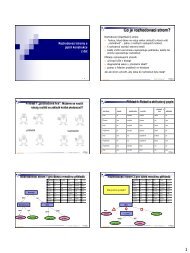Planning: Part 3 Planning Graphs
Planning: Part 3 Planning Graphs
Planning: Part 3 Planning Graphs
Create successful ePaper yourself
Turn your PDF publications into a flip-book with our unique Google optimized e-Paper software.
PLANNING GRAPHS
<strong>Planning</strong> <strong>Graphs</strong><br />
<strong>Planning</strong> graphs are an efficient way to create<br />
a representation of a planning problem that<br />
can be used to<br />
Achieve better heuristic estimates<br />
Directly construct plans<br />
<strong>Planning</strong> graphs only work<br />
for propositional problems.
<strong>Planning</strong> <strong>Graphs</strong><br />
<strong>Planning</strong> graphs consists of a seq of levels<br />
that correspond to time steps in the plan.<br />
Level 0 is the initial state.<br />
Each level consists of a set of literals and a<br />
set of actions that represent what might be<br />
possible at that step in the plan<br />
Might be is the key to efficiency<br />
Records only a restricted subset of<br />
possible negative interactions among<br />
actions.
<strong>Planning</strong> <strong>Graphs</strong><br />
Each level consists of<br />
Literals = all those that could be true at that<br />
time step, depending upon the actions<br />
executed at preceding time steps.<br />
Actions = all those actions that could have<br />
their preconditions satisfied at that time step,<br />
depending on which of the literals actually<br />
hold.
PG Example<br />
Init(Have(Cake))<br />
Goal(Have(Cake) Eaten(Cake))<br />
Action(Eat(Cake),<br />
PRECOND: Have(Cake)<br />
EFFECT: ¬Have(Cake) Eaten(Cake))<br />
Action(Bake(Cake),<br />
PRECOND: ¬ Have(Cake)<br />
EFFECT: Have(Cake))
PG Example<br />
Create level 0 from initial problem state.
PG Example<br />
Add all applicable actions.<br />
Add all effects to the next state.
PG Example<br />
Add persistence actions (inaction = no-ops) to<br />
map all literals in state S i to state S i+1.
PG Example<br />
Identify mutual exclusions between actions and<br />
literals based on potential conflicts.
Mutual exclusion<br />
A mutex relation holds between two actions<br />
when:<br />
Inconsistent effects: one action negates the effect of another.<br />
Interference: one of the effects of one action is the negation of<br />
a precondition of the other.<br />
Competing needs: one of the preconditions of one action is<br />
mutually exclusive with the precondition of the other.<br />
A mutex relation holds between two literals<br />
when:<br />
one is the negation of the other OR<br />
each possible action pair that could achieve the literals<br />
is mutex (inconsistent support).
Cake example<br />
Level S 1 contains all literals that could result from<br />
picking any subset of actions in A 0<br />
Conflicts between literals that can not occur together<br />
(as a consequence of the selection action) are<br />
represented by mutex links.<br />
S1 defines multiple states and the mutex links are the constraints<br />
that define this set of states.
Cake example<br />
Repeat process until graph levels off:<br />
two consecutive levels are identical, or<br />
contain the same amount of literals<br />
(explanation follows later)
The GRAPHPLAN Algorithm<br />
Extract a solution directly from the PG<br />
function GRAPHPLAN(problem) return solution or failure<br />
graph INITIAL-PLANNING-GRAPH(problem)<br />
goals GOALS[problem]<br />
loop do<br />
if goals all non-mutex in last level of graph then do<br />
solution EXTRACT-SOLUTION(graph, goals,<br />
LENGTH(graph))<br />
failure<br />
if solution failure then return solution<br />
else if NO-SOLUTION-POSSIBLE(graph) then return<br />
graph EXPAND-GRAPH(graph, problem)
GRAPHPLAN example<br />
Initially the plan consist of 5 literals from the initial state and the CWA literals<br />
(S0).<br />
Add actions whose preconditions are satisfied by EXPAND-GRAPH (A0)<br />
Also add persistence actions and mutex relations.<br />
Add the effects at level S1<br />
Repeat until goal is in level Si
GRAPHPLAN example<br />
EXPAND-GRAPH also looks for mutex relations<br />
Inconsistent effects<br />
E.g. Remove(Spare, Trunk) and LeaveOverNight due to At(Spare,Ground) and not At(Spare, Ground)<br />
Interference<br />
E.g. Remove(Flat, Axle) and LeaveOverNight At(Flat, Axle) as PRECOND and not At(Flat,Axle) as<br />
EFFECT<br />
Competing needs<br />
E.g. PutOn(Spare,Axle) and Remove(Flat, Axle) due to At(Flat.Axle) and not At(Flat, Axle)<br />
Inconsistent support<br />
E.g. in S2, At(Spare,Axle) and At(Flat,Axle)
GRAPHPLAN example<br />
In S2, the goal literals exist and are not mutex with any other<br />
Solution might exist and EXTRACT-SOLUTION will try to find it<br />
EXTRACT-SOLUTION can use Boolean CSP to solve the problem or a search<br />
process:<br />
Initial state = last level of PG and goal goals of planning problem<br />
Actions = select any set of non-conflicting actions that cover the goals in the state<br />
Goal = reach level S0 such that all goals are satisfied<br />
Cost = 1 for each action.
GRAPHPLAN Termination<br />
Termination? YES<br />
PG are monotonically increasing or decreasing:<br />
Literals increase monotonically<br />
Actions increase monotonically<br />
Mutexes decrease monotonically<br />
Because of these properties and because<br />
there is a finite number of actions and literals,<br />
every PG will eventually level off
Dinner Date example<br />
Initial Conditions: (and (garbage) (cleanHands) (quiet))<br />
Goal: (and (dinner) (present) (not (garbage))<br />
Actions:<br />
Cook :precondition (cleanHands)<br />
:effect (dinner)<br />
Wrap :precondition (quiet)<br />
:effect (present)<br />
Carry :precondition<br />
:effect (and (not (garbage)) (not (cleanHands))<br />
Dolly :precondition<br />
:effect (and (not (garbage)) (not (quiet)))
Dinner Date example
Dinner Date example
Dinner Date example
Rocket domain
<strong>Planning</strong> Graph Example<br />
Rocket problem


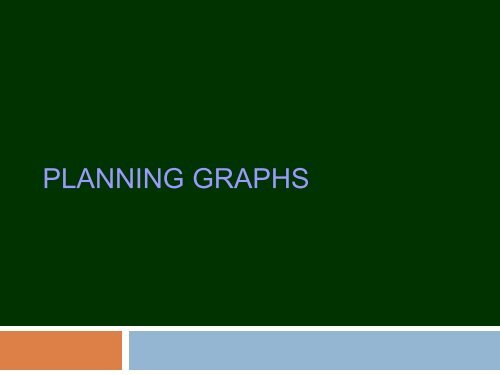

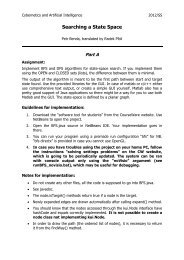
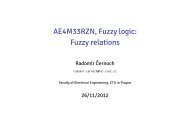


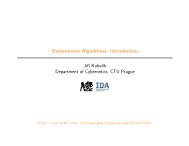
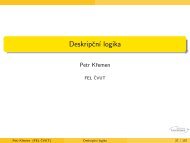


![RANSAC [Fischler, Bolles '81]](https://img.yumpu.com/17549294/1/190x143/ransac-fischler-bolles-81.jpg?quality=85)



